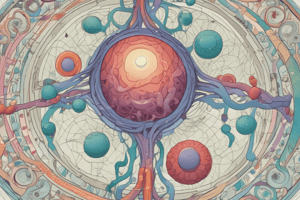Podcast
Questions and Answers
What is the primary focus of the field of genetics?
What is the primary focus of the field of genetics?
- The study of evolution and adaptation of species
- The study of heredity and the variation of inherited traits (correct)
- The study of the distribution of living organisms
- The study of the structure and function of cells
What is the molecule responsible for carrying genetic information in all living organisms?
What is the molecule responsible for carrying genetic information in all living organisms?
- Deoxyribonucleic acid (DNA) (correct)
- RNA
- Chromosome
- Protein
What determines the genetic information encoded in the DNA?
What determines the genetic information encoded in the DNA?
- The sequence of nucleotide bases (correct)
- The arrangement of chromosomes
- The number of nucleotide bases
- The sequence of amino acids
What is the result of changes in the DNA sequence?
What is the result of changes in the DNA sequence?
What is the difference between genetic variation and mutation?
What is the difference between genetic variation and mutation?
What can be a result of some mutations?
What can be a result of some mutations?
What is the primary function of genetic recombination during sexual reproduction?
What is the primary function of genetic recombination during sexual reproduction?
What is the main function of the cell membrane?
What is the main function of the cell membrane?
Which type of cell division occurs in somatic cells?
Which type of cell division occurs in somatic cells?
What is the jelly-like substance inside the cell membrane where organelles perform different functions?
What is the jelly-like substance inside the cell membrane where organelles perform different functions?
What is the process by which cells exchange materials with the environment?
What is the process by which cells exchange materials with the environment?
What is the study of the structure, function, and behavior of cells?
What is the study of the structure, function, and behavior of cells?
Flashcards are hidden until you start studying
Study Notes
Biology: An Overview of Genetics and Cell Biology
Biology is the study of life and living organisms. It encompasses various disciplines, such as the study of distribution, evolution, function, growth, and other essential features of any living organism. In this article, we focus on two significant subtopics in biology: genetics and cell biology.
Genetics
Genetics is the study of heredity and the variation of inherited traits. It includes the molecular mechanisms that control the transfer of genetic information from one generation to the next. The field of genetics is crucial in understanding how traits are passed down through generations and how genetic variations can lead to differences between individuals and species.
DNA and Genetic Information
Deoxyribonucleic acid (DNA) is the molecule responsible for carrying the genetic information in all living organisms. DNA is made up of four nucleotide bases - adenine (A), cytosine (C), guanine (G), and thymine (T) - arranged in a double helix structure. The sequence of these bases determines the genetic information encoded in the DNA.
Genetic Variation and Mutations
Genetic variation is the differences in genetic material between individuals within a species or between different species. Mutations are changes in the DNA sequence that can lead to genetic variations. Some mutations can be beneficial, while others can be harmful, leading to genetic disorders or diseases.
Genetic Recombination and Sexual Reproduction
During sexual reproduction, the genetic material from two parents is combined to form a new individual. This process, called genetic recombination, ensures genetic diversity and allows for the transfer of beneficial traits from one generation to the next.
Cell Biology
Cell biology is the study of the structure, function, and behavior of cells - the basic unit of life. Cells can be unicellular (containing only one cell) or multicellular (composed of multiple cells). Understanding cell biology is crucial in understanding the functioning of living organisms, their growth, and their response to various stimuli.
Cell Structure and Function
Cells have a specific structure and organization that allows them to carry out their functions. The cell membrane, also known as the plasma membrane, is a selectively permeable barrier that separates the cell's interior from the external environment. The cytoplasm is the jelly-like stuff inside the cell membrane, where various organelles perform different functions. The nucleus, located in the center of the cell, contains the cell's genetic material - DNA.
Cell Division and Growth
Cells can reproduce by dividing, creating two identical daughter cells. This process, called cell division, is essential for growth, repair, and the formation of new tissues. There are two main types of cell division: mitosis, which occurs in somatic cells (non-reproductive cells), and meiosis, which occurs in reproductive cells (sperm and egg cells) to produce gametes.
Cellular Processes and Signaling
Cells undergo various processes to maintain their internal environment and respond to external stimuli. These processes include cellular respiration, which provides energy for cellular functions; exocytosis and endocytosis, which allow the cell to exchange materials with the environment; and signal transduction, which allows cells to respond to external signals.
In summary, biology is a vast field of study that covers various disciplines, including genetics and cell biology. Understanding these subtopics is crucial in understanding the fundamental processes that govern the life and behavior of living organisms.
Studying That Suits You
Use AI to generate personalized quizzes and flashcards to suit your learning preferences.




